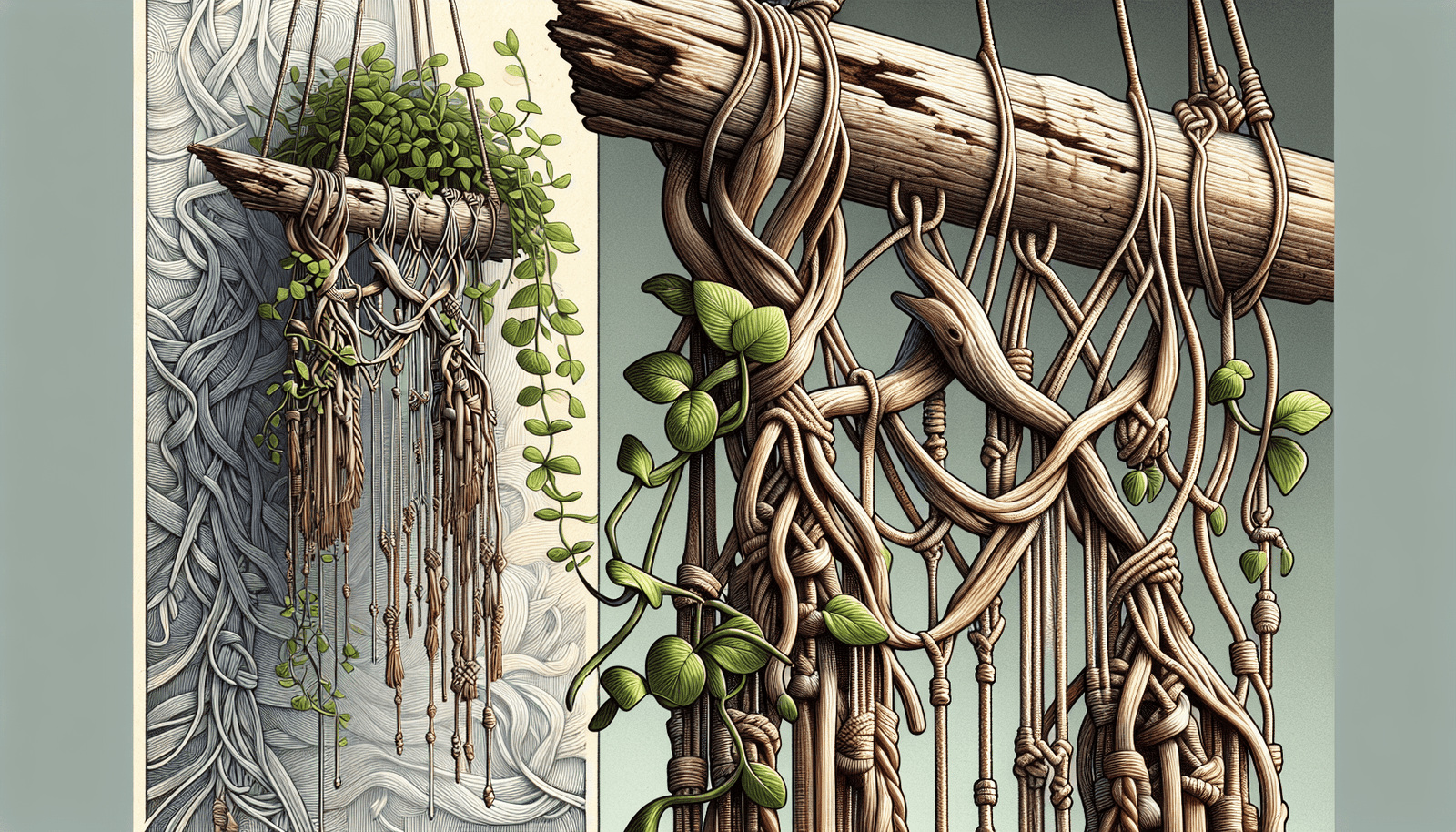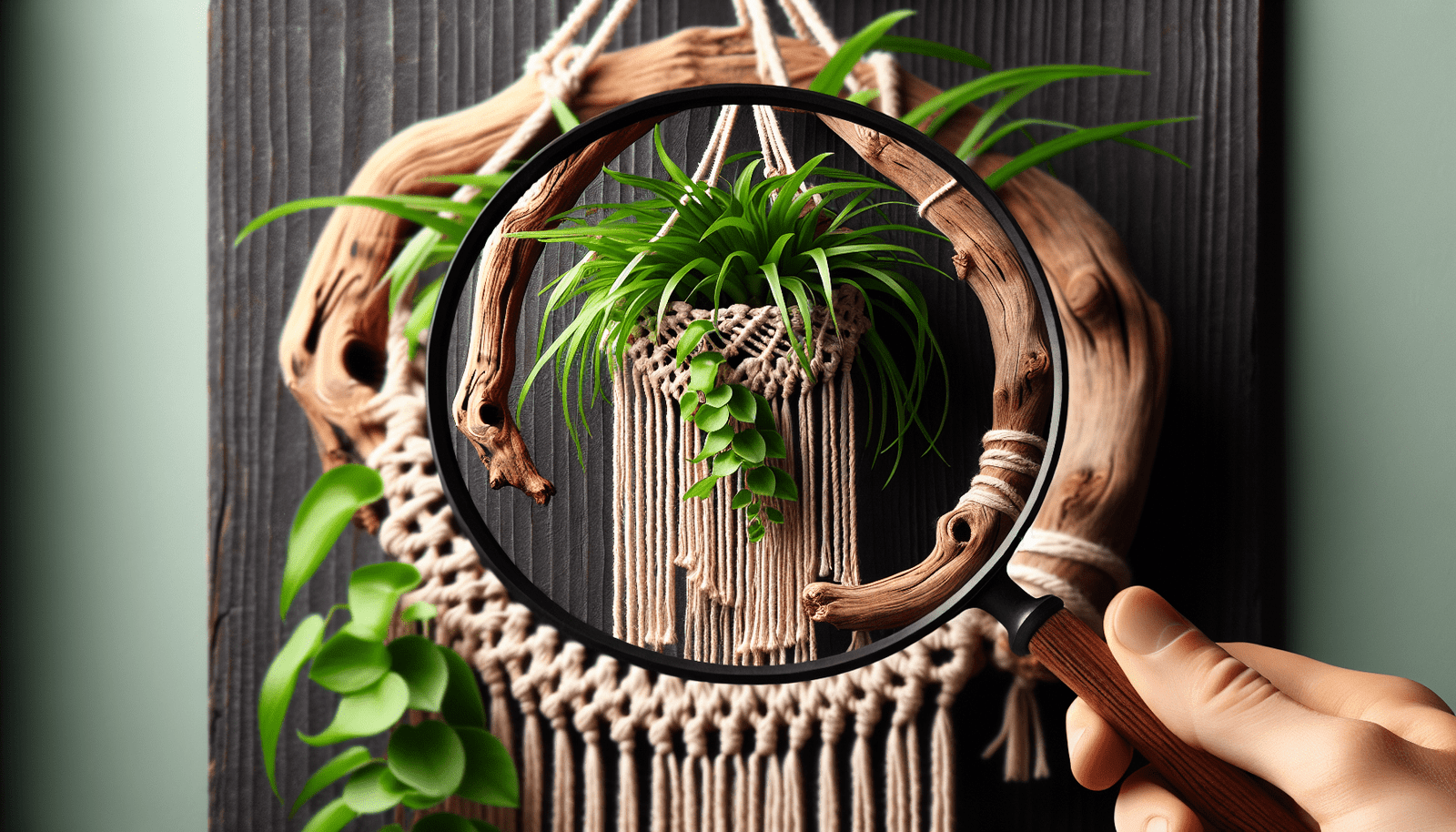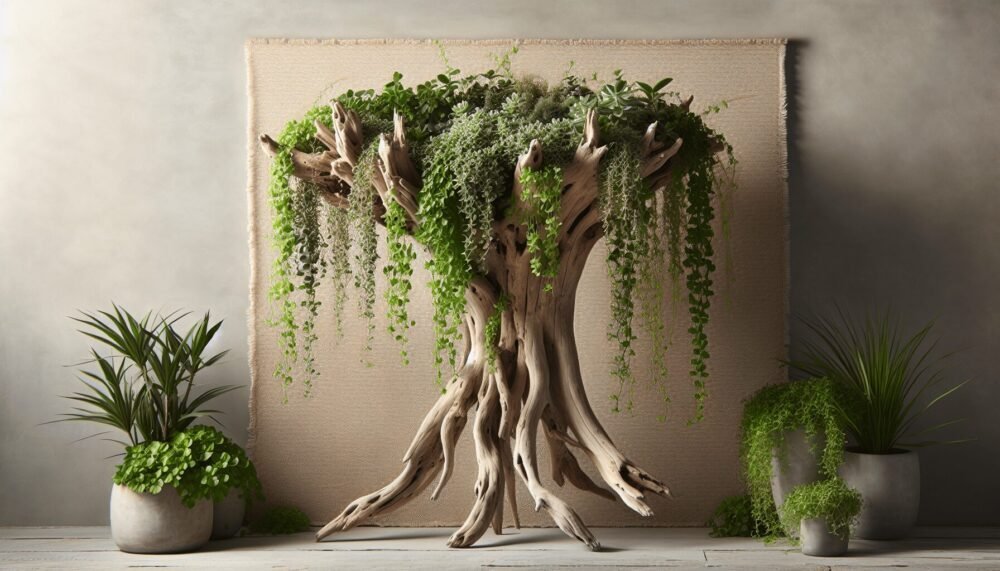Have you ever gazed upon the intriguing charm of driftwood and wondered how you could incorporate it into your home décor? Driftwood is more than just a relic from the beach; it’s a unique, natural element that can elevate your interior design in ways that are both rustic and elegant. In this guide, you’ll learn how to create a beautiful and functional driftwood macrame plant hanger that will not only spruce up your space but also bring a bit of the outdoors inside.

Understanding Driftwood and Its Appeal
Driftwood, swept by waves and polished by time, carries with it a story of journey and resilience. Its coarse texture and unique shapes offer a glimpse into nature’s raw beauty. Integrating driftwood into home décor has gained popularity due to its sustainable nature and aesthetic value.
Why Choose Driftwood for a Macrame Project?
Driftwood serves as an excellent medium for macrame projects because of its strength and visual appeal. Each piece is unique, granting a one-of-a-kind outcome to your creations like plant hangers. Its irregular shapes provide an interesting contrast to the uniformity of macrame knots, creating a fascinating visual dynamic.
Benefits of Using Driftwood in Home Decor
Utilizing driftwood in your decor can infuse your home with a sense of calm and earthiness. It’s a sustainable choice as it repurposes elements already present in nature. Moreover, its neutral tones make it versatile, blending seamlessly with various color schemes and styles from modern to coastal.
The Art of Macrame: A Brief Overview
Macrame is the art of knotting cords or strings in patterns to make decorative and functional objects. With roots tracing back centuries, it has evolved from traditional textiles to a modern craft form that’s perfect for home decor.
Key Macrame Knots for Beginners
To begin your macrame journey, you need to familiarize yourself with a few basic knots. Here’s a quick overview:
- Square Knot: This is the cornerstone of many macrame projects. It involves four strands: the outer two are working cords, and the inner two are filler cords.
- Half Hitch Knot: By knotting around a central cord, you create a chain that can form spirals.
- Lark’s Head Knot: Commonly used to attach cords to a piece of driftwood, it’s simple and sturdy.
| Knot Name | Description |
|---|---|
| Square Knot | Creates a flat, wide knot. |
| Half Hitch | Used for making rows or spirals. |
| Lark’s Head | Secures cords to driftwood. |
The Appeal of Combining Driftwood and Macrame
When you combine driftwood and macrame, you get the best of both worlds: the rugged, natural beauty of driftwood and the intricate patterns and textures of macrame. This pairing is particularly enchanting for plant hangers as it not only cradles your green friends but also adds an artistic touch to any room.
Creating Your Driftwood Macrame Plant Hanger
Let’s now venture into the step-by-step creation of your own driftwood macrame plant hanger. Gather your tools and materials and prepare to transform them into art.
Materials Needed
To embark on this project, you’ll need the following materials:
- Driftwood piece of your choice
- Macrame cord (3-4mm thickness recommended)
- Scissors
- Tape measure
- Plant pot
- Hooks or ceiling mounts for hanging
Choosing the Right Driftwood
Select a piece of driftwood that’s sturdy, not brittle, and appropriately sized for the hanging space. Its shape should balance aesthetics with functionality, providing places for your cords to attach securely.
Preparing the Materials
Before you start knotting, measure and cut your macrame cords into lengths that fit your specific project. An average plant hanger typically requires cords that are about four to five times the desired finished length. You may want to start longer and trim down later to ensure you have enough material.
Step-by-Step Guide to Crafting a Driftwood Macrame Plant Hanger
Now that your materials are ready, let’s dive into the creation process. Each step below will guide you through making a simple yet beautiful driftwood macrame plant hanger.
Step 1: Attach Cords to Driftwood
Using the Lark’s Head Knot, attach your macrame cords to the driftwood. This will act as the foundation for your design. Ensure the cords are secured evenly along the driftwood to distribute weight properly.
Step 2: Form the Main Pattern
Create your main pattern using square knots. You can get creative here: form a tightly knit section at the top and then gradually loosen the pattern as you move down, or mix it up with different knot styles for varied textures.
Step 3: Create the Plant Holder
Use a series of square knots and spiral patterns to form a basket or cradle where the plant pot will sit. Ensure this section is snug enough to hold the pot securely but loose enough to insert or remove the pot easily.
Step 4: Finishing and Trimming
Once your main structure is complete, trim excess cords to your desired length, creating a tassel effect if you wish. Ensure everything is even and robust enough to hold the weight of your plant.
Step 5: Final Assembly and Hanging
Attach your finished macrame piece to hooks or ceiling mounts in your desired location. Ensure the space receives adequate light if you’re planning to hang living plants.

Maintenance and Care for Your Plant Hanger
Maintaining your driftwood macrame hanger ensures it stays beautiful and functional for years to come. Here are some quick tips.
Caring for Driftwood
While driftwood is durable, it benefits from occasional cleaning to remove dust and buildup. Gently wipe it with a damp cloth, being careful not to disturb the macrame knots.
Macrame Cord Maintenance
Macrame cords can collect dust, especially in high-traffic areas. Light vacuuming or gentle shaking can help keep them clean. If necessary, spot clean using mild soap and water.
Tips for Plant Care in a Hanger
When watering the plant, ensure water doesn’t spill excessively onto the macrame cords as this may lead to discoloration. Opt for plants that thrive in hanging environments, such as trailing ivy or spider plants, which can cascade beautifully from the hanger.
Creative Variations and Personalization
Once you’ve mastered the basics, consider experimenting with different types of driftwood or macrame patterns. This customization can reflect your personal style or blend seamlessly with existing decor.
Exploring Different Macrame Patterns
Dive into more advanced macrame patterns such as the Josephine knot or clove hitch for an added challenge. These sophisticated designs can significantly enhance the visual appeal of your plant hangers.
Incorporating Different Materials
While driftwood is a fantastic choice, you can also incorporate other materials like copper pipes or metal hoops for a modern twist. Mixing different textures and materials can create a truly unique and striking piece.
Adding Decorative Elements
You can also embellish your macrame hanger with beads, feathers, or painted accents on the driftwood. These additions offer a playful touch, allowing for seasonal or thematic decorations.
The Environmental Impact and Sustainability
Driftwood macrame hangers are not just stylish; they’re a nod to sustainability. Embracing this form of decor supports eco-friendly practices and conscious living.
Sourcing Sustainable Driftwood
Ensure your driftwood is sourced responsibly. Collect pieces found naturally washed ashore without disturbing local wildlife habitats or removing too much from delicate ecosystems.
Reducing Waste with DIY Projects
Creating your own home decor reduces the demand for mass-produced items, often made with non-renewable materials. Crafting with driftwood and natural fibers promotes creativity while minimizing waste and overproduction.
Conclusion: Bringing It All Together
Creating a driftwood macrame plant hanger is more than just a project; it’s a journey into the appreciation of nature’s beauty and the joy of crafting. This timeless piece will not only adorn your space but also serve as a gentle reminder of the harmony between aesthetic appeal and sustainable living. Whether you’re a seasoned crafter or a beginner, the art of combining driftwood and macrame offers endless possibilities, accentuating your living space with rustic charm and personal flair.

